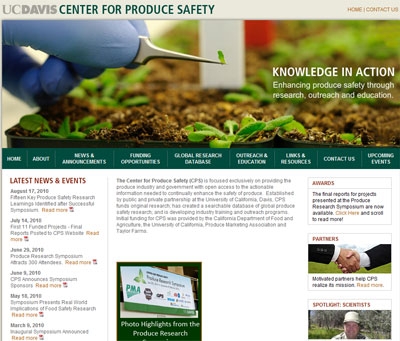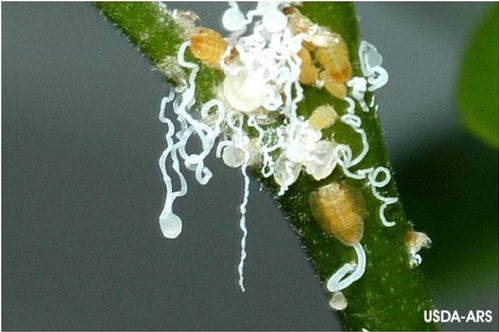
Posts Tagged: exotic pests
Protect the environment by leaving firewood at home

When people move wood from place to place, they may also be moving invasive insects and diseases that threaten California's landscape and wildland trees. The goldspotted oak borer, which is devastating native oaks in San Diego, likely hitchhiked from Arizona in firewood. The polyphagous shothole borer, walnut twig beetle and thousand cankers disease, and the pathogen causing sudden oak disease, all continue to spread to new areas on infested wood chips, plant debris or wood moved for woodworking or firewood.
Over the past year, the California Firewood Task Force has asked the public to "buy it where you burn it" — that is, don't bring wood from home when you camp, do use wood from local sources, and leave leftover wood at the campsite for the next camper. Even if wood does not appear to have borer holes or other evidence of pests, don't assume that the wood is pest free. Be on the safe side and don't move it.
The California Forest Pest Council established the task force in 2011 to educate Californians about what they can do to prevent movement of invasive pests in wood. The task force developed a web site, put up billboards across California, sponsored children's activities at parks and fairs, encouraged campgrounds to sell only local firewood, gave presentations across the state, and developed best management practices, posters, and other information to engage the public.
For more information visit www.firewood.ca.gov/.
How invasive species threaten California’s plant ecosystems
DAVIS -- What new invasive species threaten California’s plant ecosystems? How do you educate people and organizations about the threat of invasive species? And, how can you help detect and exclude them?
An all-day conference April 24 at UC Davis will answer those questions. The event runs from 8 a.m. to 5 p.m. in the UC Davis Conference Center, at 550 Alumni Lane, across from the Mondavi Center for the Performing Arts.
Themed “Educating the Public about New Invasive Species Threatening California’s Plant Ecosystems,” the conference will include such topics as “New Pests Threatening California,” “Case Histories” and “Other Perspectives on Communication,” said coordinator Kris Godfrey, associate project scientist with the Contained Research Facility at UC Davis.
“The public needs to become more aware of the threat of invasive species,” said Godfrey, formerly with the California Department of Food and Agriculture. "The goal of this conference is to bring together biologists, social scientists, and communication experts to discuss how to educate all segments of society about the threat of invasive species and how to assist in their exclusion and detection.”
Conference attendees will learn about developing and delivering effective and consistent messages about invasive species to a variety of audiences, Godfrey said. They also will learn how to access the resources available to conduct effective outreach programs on invasive species.
Speakers will examine pest plants and plant pests that are likely to enter California in the near future, the pathways of introduction and likelihood of entry, and examples of successful outreach programs that resulted in changes in behavior by segments of society. “Methods to overcome barriers to communication with various segments of the population and possible new methods of communication” will also be discussed, Godfrey said.
Registration is free for UC personnel and $25 for non-UC personnel.
Invasive pest topics on the agenda include the golden spotted oak borer, Asian citrus psyllid, European grapevine moth, Japanese dodder, sudden oak death, and zebra and quagga mussels.
Among the speakers:
- "Predicting the Next Pest Invaders and How To Prevent Their Introduction," Joseph DiTomaso, UC Davis Department of Plant Sciences
- “New Pest Plants,” Doug Johnson, California Invasive Plant Council, Berkeley
- “New Arthropod Pests,” Kevin Hoffman, California Department of Food and Agriculture, Sacramento
- ”New Plant Pathogens,” Richard Bostock, UC Davis Department of Plant Pathology
- ”Zebra and Quagga Mussels,” Ted Grosholz, UC Davis Department of Environmental Science and Policy
- “European Grapevine Moth,” Lucia Varela, UC Cooperative Extension, Sonoma County
- ”Asian Citrus Psyllid/Huanglongbing,” Beth Grafton-Cardwell, UC Riverside Department of Entomology
- “Sudden Oak Death and Buy-Where-You-Burn Campaigns,” Janice Alexander, UC Cooperative Extension, Marin County, Novato.
- “Japanese Dodder, “Ramona Saunders, Sacramento County Agricultural Commissioner’s Office
- “Newspaper Perspective,” Matt Weiser, Sacramento Bee
More information, including the full agenda and updates on the conference, is available at http://crf.ucdavis.edu. Conference registration is online at https://registration.ucdavis.edu. For additional information, contact Kris Godfrey at kegodfrey@ucdavis.edu or (530) 754 2104.
The conference, supported with a grant from the UC Davis College of Agricultural and Environmental Sciences’ 2011 Spring Programmatic Initiative, is a cooperative project of the UC Davis College of Agricultural and Environmental Sciences, the UC Davis departments of Plant Pathology, Entomology, Plant Sciences, and Food Science and Technology, the California Center for Urban Horticulture at UC Davis, the UC Statewide Integrated Pest Management Program, and the UC Riverside Department of Entomology.

Asian citrus psyllid infestation.
USDA provides funds for California specialty crops research
The USDA issued a news release on Friday announcing $55 million in block grants to enhance the competitiveness of specialty crops around the country, with California receiving more than $17 million. Of the 64 California projects, 19 are led by researchers affiliated with UC Agriculture and Natural Resources.
A large share of funding - $1.4 million - goes to nine food-safety projects to be coordinated by UC’s Center for Produce Safety, according to an article in the Fresno Bee.
"Scientists and researchers with the University of California and industry groups are exploring everything from whether frogs and lizards are potential carriers of E.coli to whether dust from a cattle operation can carry E.coli into a vegetable field," wrote Bee reporter Robert Rodriguez.
The executive director of the Center for Produce Safety, Bonnie Fernandez, told Rodriguez the funding comes at a time of heightened awareness of food safety among consumers and farmers.
"There are simply a lot of unanswered gaps of knowledge on these issues," Fernandez was quoted. "We want to know where the pathogens came from, how it attaches to a product and how we can reduce the risk of that happening."
Management of exotic pests is another issue where USDA provided funding for UC research, according to the listing on USDA's website. For example, grants will support efforts to:
- Release and evaluate four exotic olive fruit fly parasitoids in order to improve sustainable table and oil olive management
- Test the area-wide application of mating disruption of vine mealybug in Napa County
- Evaluate the efficacy of organic pesticides for Asian Citrus Psyllid control so science-based control recommendations can be made to organic citrus growers
- Survey resistance ratios in olive fruit fly populations from California regions not sampled in a previous study
Funds were also made available to expand and improve the online specialty crop production information now available on UC's Fruit & Nut Research and Information Center website and call-in center.
In addition, the new funding will allow UC researchers to work with several school districts and their regional partners to expand their procurement of local seasonal fresh produce, enhance their ability to integrate a specialty crop nutritional curriculum by providing outreach and professional development to school personnel, and assess changes in food preferences and dietary behaviors of children in participating school.
Other UC projects receiving the funding will look into onion seed production, strawberries' ability to restore impaired insulin, steam injection for soil disinfestation, and mealy plum aphid and leaf-curl plum aphid control in prunes.

The UC Center for Produce Safety to receive substantial research funds from USDA.
UC academics raise Asian citrus psyllid awareness
Be prepared with a plan, warns UC Cooperative Extension farm advisor Craig Kallsen, for the very real possibility of an Asian Citrus Psyllid quarantine area in Kern County, according to an article he authored that was published in Western Farm Press yesterday.If the pest appears in the San Joaquin Valley's southernmost county, farmers will face a distinct challenge. Most of the citrus fruit harvested in Kern County is shipped to other counties for packing. If the county were to be quarantined, farmers would have to make sure the fruit has been processed and cleaned well enough to eliminate all plant parts - including leaves, stems and debris - and all life stages of the Asian citrus psyllid before shipping to packing houses.
"(The fact) that much of Kern County’s fruit is packed outside the county may make compliance with quarantine regulations potentially more difficult for many growers and packers that produce fruit in Kern County," Kallsen wrote.
Meanwhile, an article by freelance writer Dan Bryant, published earlier this week in Western Farm Press, outlined how the citrus industry is gearing up for Huanglongbing, the devastating citrus disease that can be spread by Asian citrus psyllid (to date, the disease has not appeared in California.)
The story included advice from UC Riverside citrus entomologist Beth Grafton-Cardwell. She told the reporter the telltale, early signs of Huanglongbing are yellowing of newly-flushed citrus foliage.
If Huanglongbing arrives in California, it could be distributed rapidly by the Asian citrus psyllid through backyard plants before moving on to commercial citrus. In that case, nurseries will have to place nursery stock in screen houses to keep it from the Asian citrus psyllid. Some, she said, have already prepared structures.

Immature Asian citrus psyllids.
Another attentive dog averts disaster
A FedEx package filled with curry leaves and guavas arrived in Sacramento Wednesday infested with 100 Asian citrus psyllids, the Los Angeles Times reported today. In a scenario eerily similar to one that took place in Fresno two weeks ago, a trained dog alerted authorities to the package, the pests were trapped, analyzed at a lab and determined to be free of the bacteria that causes the citrus disease Huanglongbing (HLB).The package destined for Fresno was mailed from India; the package in Sacramento came from Houston, Texas.
"We know that this has been going on but it is just now that we are getting a feeling for how bad it is as we get more federally funded dog teams out there," the article quoted Beth Grafton-Cardwell, a UC Riverside citrus entomologist based at the UC Lindcove Research and Extension Center in Exeter.
UC scientists are working with CDFA, USDA and the citrus industry to prevent establishment of Asian citrus psyllid in California. But the effort has been met with several recent setbacks. Their greatest fear is for the incurable HLB disease that the psyllid transmits.
Psyllids not infected with HLB were found in Imperial and San Diego counties early last year; this week isolated populations turned up Los Angeles and Orange county backyard citrus trees.
Grafton-Cardwell believes the pests' eventual spread through the state's citrus regions is inevitable.
"It's only a matter of time before the huanglongbing disease finds its way to California from Mexico or elsewhere," Grafton-Cardwell told LA Times reporter Jerry Hirsch.

White, waxy tubules are a tell-tale sign of Asian citrus psyllid.
